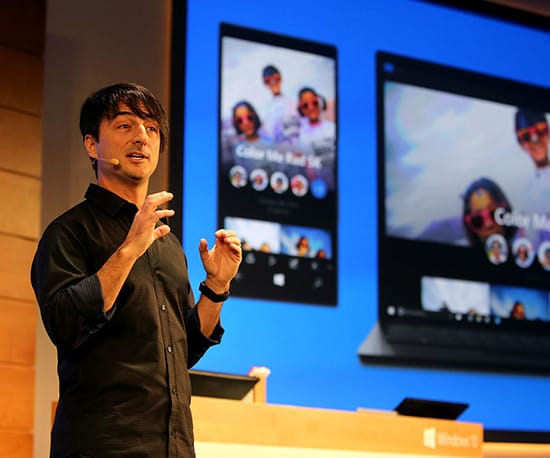
BitDepth#973 for January 27

Microsoft’s Joe Belfiore explains the new photo organisation features of Windows 10. Photo courtesy Microsoft.
Last week, Microsoft made it clear that it wasn’t going into the deployment of Windows 10 with any assumptions about its customer base.
The new version of Windows, which is still to be assigned a release date, got more new features and one big change that clearly targets the gun-shy among its users.
Windows 10, on release, will be free to anyone running the last two major versions of the software, Windows 7 and Windows 8, for one year.
There is no announced lifeline for users who may be stranded on the late and unlamented Windows Vista, but with a current marketshare of 2.9 per cent, the company is probably right to ignore the smallest sector of the recent Windows installs (by comparison, Windows XP still holds 18.9 percent of the installed user base).
This also puts Microsoft in the interesting position of following Apple into the uncharted realm of making once commercially viable software available for free.
Apple given away the last two major updates to its computer systems.
But Microsoft doesn’t have a lucrative hardware business running under Windows and may find itself in search of a different business model in the wake of a year’s worth of free Windows upgrades.
Free Windows 10 looks great for upgraders, not for over the counter sales of the product.
The new strategy is likely to constitute a customer friendly approach to addressing the diminishing enthusiasm that the corps of Windows users have expressed for recent upgrades and an effort to align the core operating system with the company’s new Windows everywhere direction.
In a blog post on the last week’s update news for Windows 10, Microsoft’s Terry Myerson explained: “We think of Windows as a Service – in fact, one could reasonably think of Windows in the next couple of years as one of the largest Internet services on the planet.”
New features will be rolled into the product as they are completed not held for a future monolithic update as tends to be the norm with operating system updates.
As described, versioning will either disappear or become more obscure, as it has with Adobe’s Creative Suite under that company’s new continuous update programme, Creative Cloud.
That isn’t to say that there aren’t interesting features available right now.
Microsoft has announced that its personal digital assistant software, Cortana, will make the jump from Windows Phone to the desktop, where the software will be available to answer questions and handle voice commands to do neat stuff like set up an e-mail for you.
The company’s gaming product Xbox is more tightly integrated into the Windows ecosystem and the new, fast, lean (and web standards compliant) browser Spartan looks promising but a new iteration of Windows just isn’t exciting without a wildly improbable new feature that absolutely nobody has asked for.
For Windows 10 that’s going to be Hololens, which seeks to one-up augmented reality, VR and Google Glass in one fell stroke with a wild 3D intrusion into your everyday world.
Like Kinect, it seems like a solution in search of a problem, but then, look what happened to Kinect.
The newest build of Windows 10 is available at the Windows Insider website (requires sign up), and the usual cautions apply.
Doubly so this time because I managed to completely bork an existing installation of Windows 8.1 by paying poor attention to the rather enervating succession of restarts and buttons that require carefully considered choices in the live installer (which also managed to completely fail twice).
I clicked one thing when I should have clicked another, and now I’ve got a computer screen flashing on and off. Before I can report on the changes in the newest version, I’ll have to nuke and pave using one of the download ISO images.
So really, when Microsoft says “Remember, trying out an early build like this can be risky,” they aren’t kidding or being overcautious. Test builds are not finished software. You have been warned.


